Climbing walls for kids are becoming increasingly popular as both a fun activity and a developmental tool. They offer a unique combination of physical exercise, mental challenge, and safe risk-taking that contributes to the growth of children. Designed specifically for younger climbers, these walls are typically shorter than standard climbing walls and feature colorful hand and foot holds to captivate children’s attention.
Safety is a primary consideration in kids’ climbing walls, and they often incorporate softer landing surfaces and closer supervision requirements to ensure a safe climbing environment. These walls can be found in various settings, including playgrounds, recreational centers, and specialized climbing facilities that cater to a younger audience.
Through engaging in climbing, children develop important life skills such as problem-solving, perseverance, and confidence. Climbing walls tailored for kids are constructed with their developmental needs in mind, ensuring that the challenges presented are age-appropriate and cater to various skill levels, allowing for progressive skill development.
Reader's Roadmap
Benefits of Climbing Walls for Kids
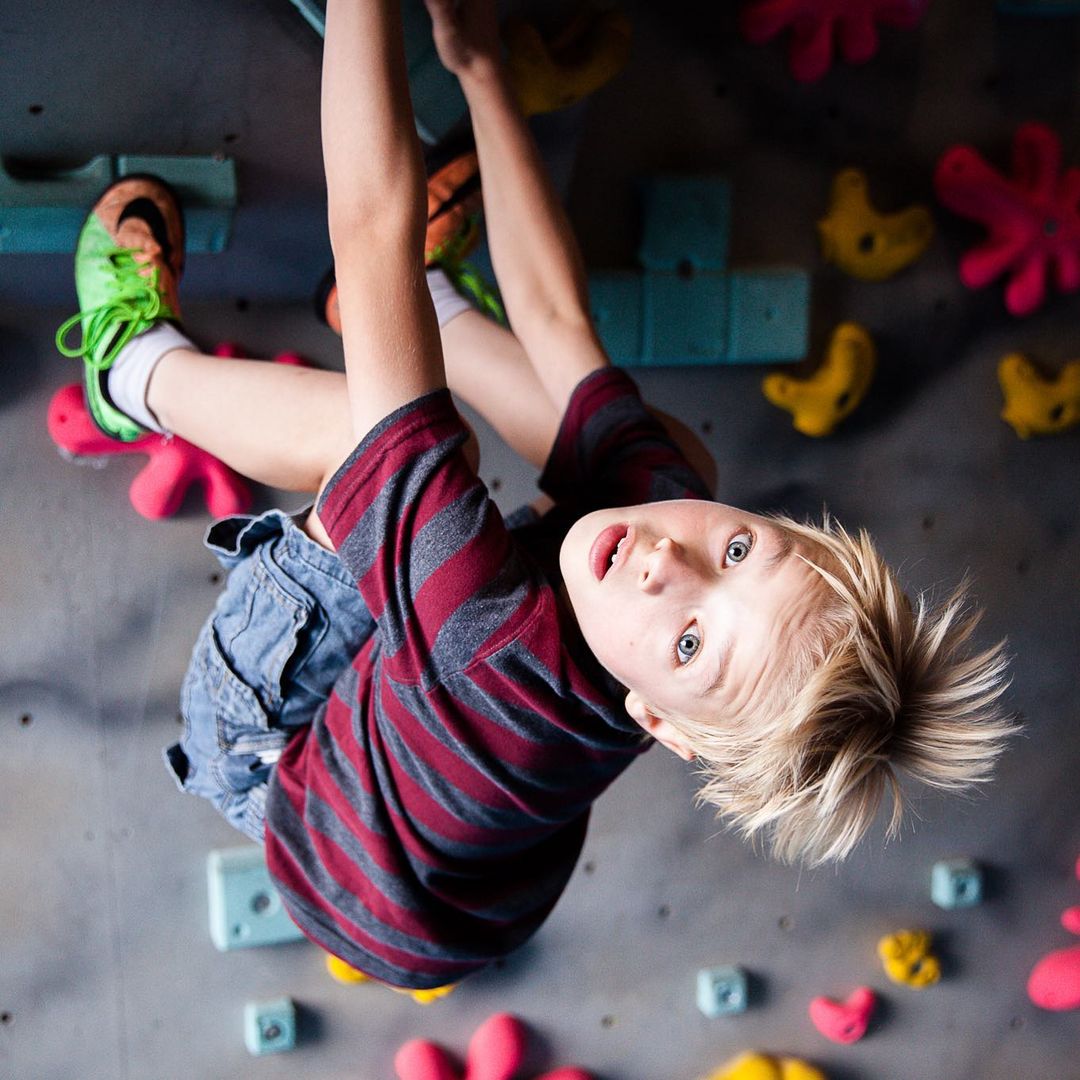
Climbing walls present a unique combination of physical and mental challenges for children, which can lead to numerous developmental benefits. These structures encourage kids to engage their entire bodies and minds in a way that is both fun and beneficial.
Development of Motor Skills
Climbing walls require children to use both gross and fine motor skills. As they reach, grasp, and move, kids enhance their dexterity and hand-eye coordination. They learn how to balance and coordinate complex movements, which can improve their performance in other physical activities as well.
Promotion of Strength and Fitness
Climbing is a full-body workout that promotes muscle development and cardiovascular health. Regularly engaging with a climbing wall can lead to:
- Increased muscle strength: particularly in the arms, legs, and core.
- Enhanced endurance: climbing for extended periods boosts cardiovascular stamina.
Cognitive and Social Benefits
Climbing walls also offer cognitive challenges that can lead to problem-solving improvements. Children must assess routes and make split-second decisions during their climb, which can improve their decision-making skills.
Socially, climbing can be highly beneficial for kids. It often involves:
- Teamwork: Children learn to work together and support one another.
- Trust-building: When belaying or spotting is involved, children understand the importance of trust and communication.
By engaging with climbing walls, kids not only have fun but also gain skills that are transferable to many other aspects of their lives.
Essential Materials and Tools
When constructing a climbing wall for kids, opting for durable materials and having the correct tools on hand are fundamental for a safe and sturdy build.
Choosing the Right Materials
The materials chosen must ensure safety and longevity. For the wall itself, plywood is a highly recommended material due to its strength and ability to hold weight. Plywood sheets should be at least 3/4 inch thick to provide a robust base for climbing holds. To affix the holds securely, t-nuts made of galvanized steel are essential; they should be inserted from the backside of the plywood panels.
For the frame, 2x4s or 2x6s are ideal, with the choice dependent on the desired depth of the wall. It’s critical to source wood screws and bolts that are suitable for joining the frame to the wall. Screws should be long enough to penetrate the wood without compromising structural integrity. Nuts and bolts will be used for attaching the climbing holds.
Paint may be applied to the wall for aesthetic purposes, but it must be non-slip to maintain safety. Use sandpaper to smooth any rough edges on the wood surfaces, preventing splinters and ensuring a smoother texture for climbing.
Tools Required for Construction
Building a climbing wall necessitates specific tools to ensure efficient and safe construction. A drill with a variety of drill bits will be indispensable for creating pilot holes and inserting t-nuts and screws. An allen wrench is necessary for tightening the holds, while a hammer might be needed to assist in inserting t-nuts or other components.
To confirm the wall is affixed to the structural elements of a room, a stud finder is vital, ensuring the wall’s frame is properly anchored. A tape measure is needed for precise measurements, ensuring that the materials fit together correctly.
All these tools and materials must be used with precision to create a safe and enjoyable climbing experience for children.
Safety Considerations
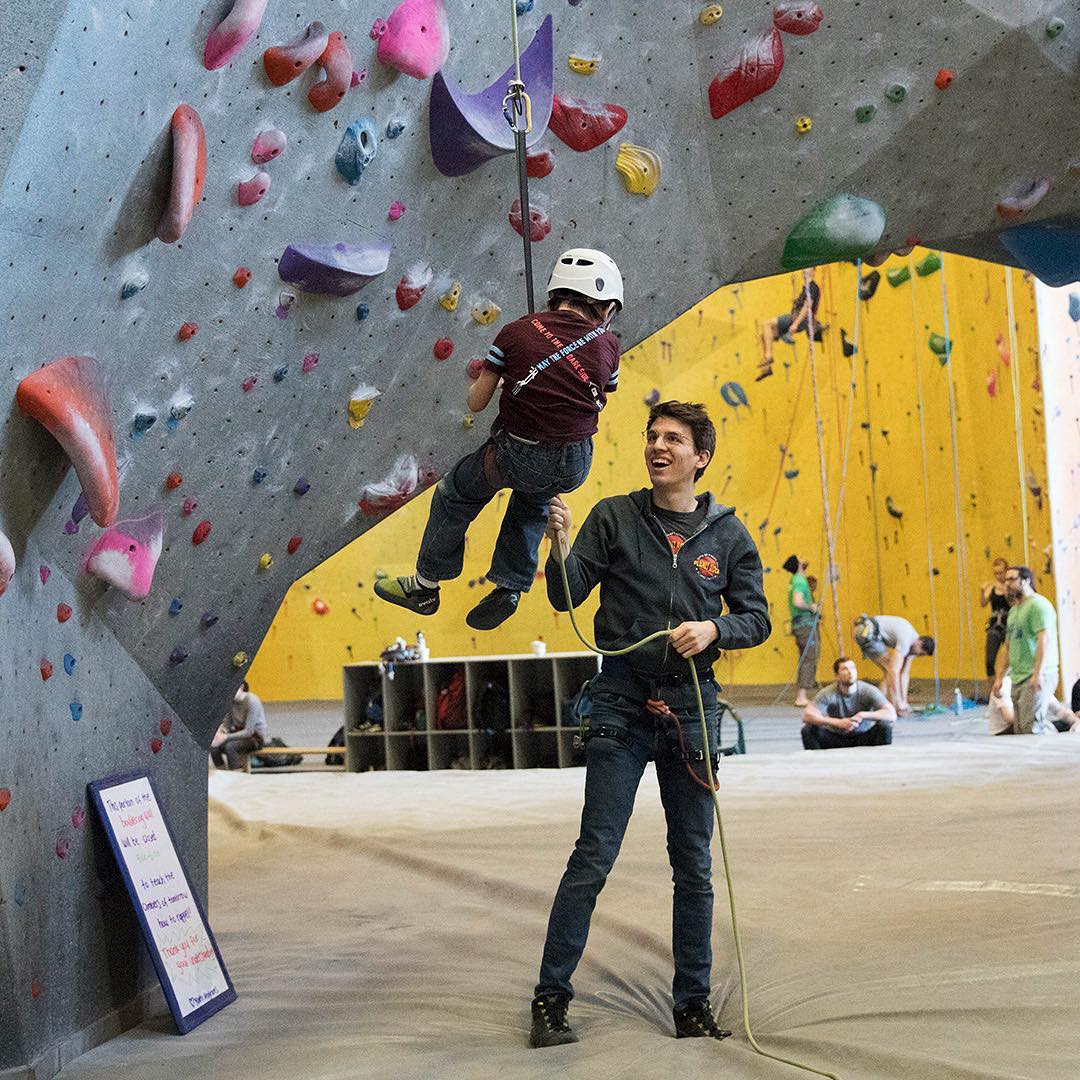
Ensuring the safety of children on climbing walls is paramount. It involves constant supervision, the use of appropriate safety gear, and the implementation of safety measures such as crash pads. Employing these strategies can significantly reduce the risk of injury.
Supervision and Safe Use
Children should always be supervised by a responsible adult when using a climbing wall. Supervisors must ensure that kids climb within their ability level and follow all the provided safety instructions. Furthermore, establishing and enforcing clear rules for the use of the climbing wall is crucial. For instance:
- Climbing Boundaries: Kids must stay within designated climbing areas.
- Turn-taking: Making sure children take turns avoids overcrowding on the climbing wall.
Appropriate Safety Gear
Safety gear is a vital aspect of any climbing activity. Even when climbing low walls where ropes are not typically necessary, the right gear can prevent injuries. Essential safety equipment includes:
- Helmets: Protects against head injuries from falls or from objects that might fall from the climbing wall.
- Climbing Shoes: Provides better grip and support compared to regular footwear.
- Crash Pads: These should be placed beneath the climbing wall to cushion falls and reduce the risk of injury.
Before every climbing session, an adult should inspect the safety gear for any signs of wear or damage. Only gear that is in good condition and proper working order should be used.
Designing Your Kids Climbing Wall
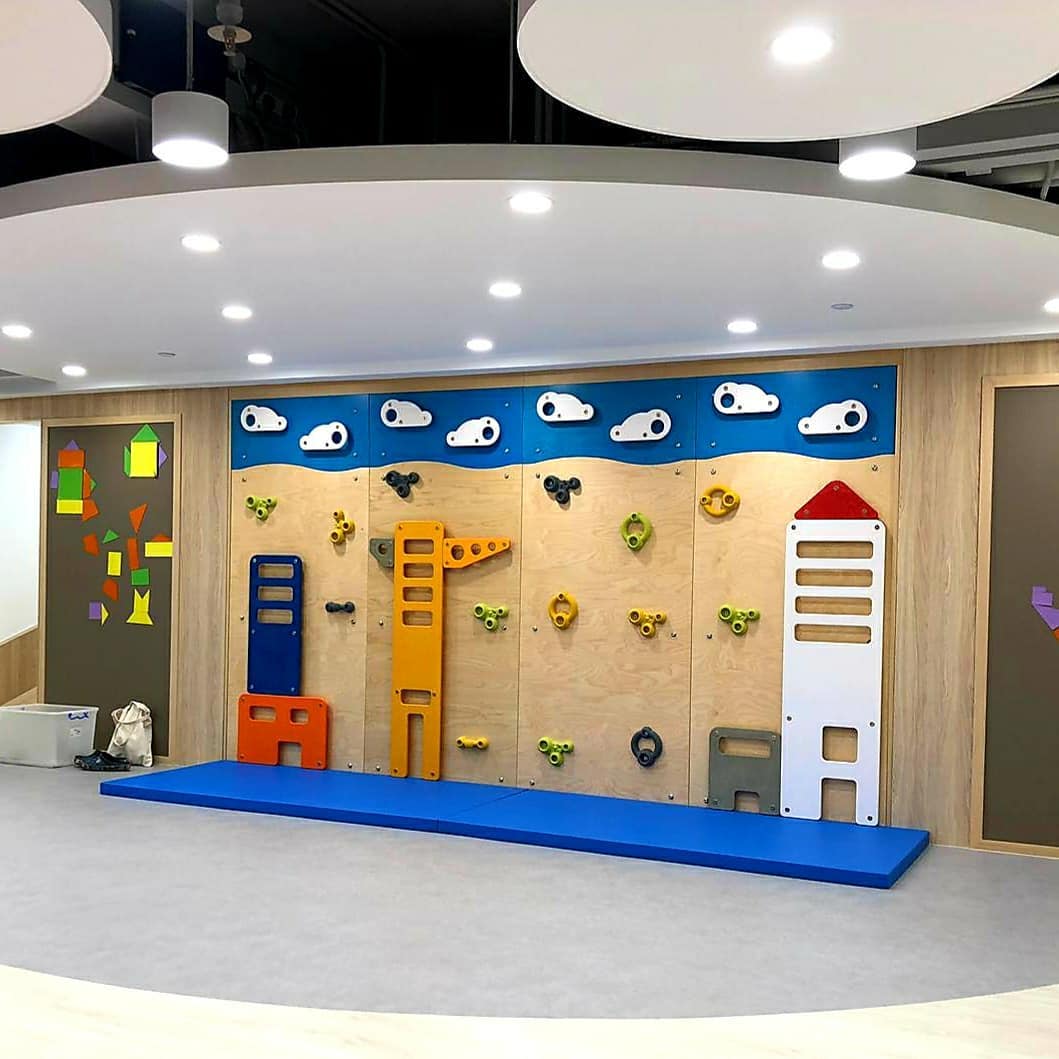
Designing a climbing wall for kids involves creativity and safety considerations. It’s important to choose engaging themes and determine a safe height.
Creative Design and Themes
When creating a climbing wall, themes play a crucial role in making the wall appealing to children. They enjoy vibrant colors and patterns that spark imagination. One can opt for a jungle theme with green and brown hues and animal-shaped holds, or a space theme with dark blues, stars, and rocket-shaped grips. Additionally, the choice of paint should be non-toxic and durable to withstand frequent use.
Themes to Consider:
- Jungle Adventure
- Outer Space Odyssey
- Underwater Voyage
- Castle Fortress
Determining the Appropriate Height
For a kid’s climbing wall, height is a critical consideration for safety and accessibility. Height recommendations vary based on age but generally should not exceed 6 to 10 feet to minimize risk. Appropriate rock climbing holds should be placed close together to allow easy reach for shorter arms.
Height Guidelines:
- Ages 3-5: Max height ~6 feet
- Ages 6-10: Max height ~8 feet
- Ages 11+: Max height ~10 feet
The design must also include reliable safety mats on the ground and regular inspection to ensure that the structure remains safe and secure for use.
Installation Process
Installing a climbing wall for kids requires attention to detail and a systematic approach to ensure safety and durability. The proper installation of holds is crucial for the structure’s functionality.
Wall Preparation
The first step involves preparing the wall that will serve as the foundation for the climbing holds. It is recommended to use a sturdy plywood sheet as the base material. The plywood should be at least 3/4 inches thick to provide sufficient support. One must also ensure that the wall is perfectly level to prevent any imbalance or tilt that could compromise safety.
- Select and prepare a smooth, flat surface.
- Attach the plywood securely to the wall studs.
Assembly and Installation of Holds
Once the wall is prepared, the assembly and installation of holds can commence. Climbing holds come in various shapes and sizes, and they should be strategically placed to create a fun yet challenging climbing experience for children.
- Drill holes in the plywood according to the holds’ arrangement.
- Fasten the holds onto the plywood using bolts.
The drill used should match the bolt size to ensure a snug fit. Bolts should be tightened securely, using a wrench, to ensure holds remain firmly in place. Regular inspection and maintenance are recommended to guarantee the holds remain safely attached over time.
Climbing holds should be installed at a kid-friendly height and distance apart. This way, children can reach and grip the holds comfortably, providing a safer climbing experience.
DIY Climbing Wall Project Steps
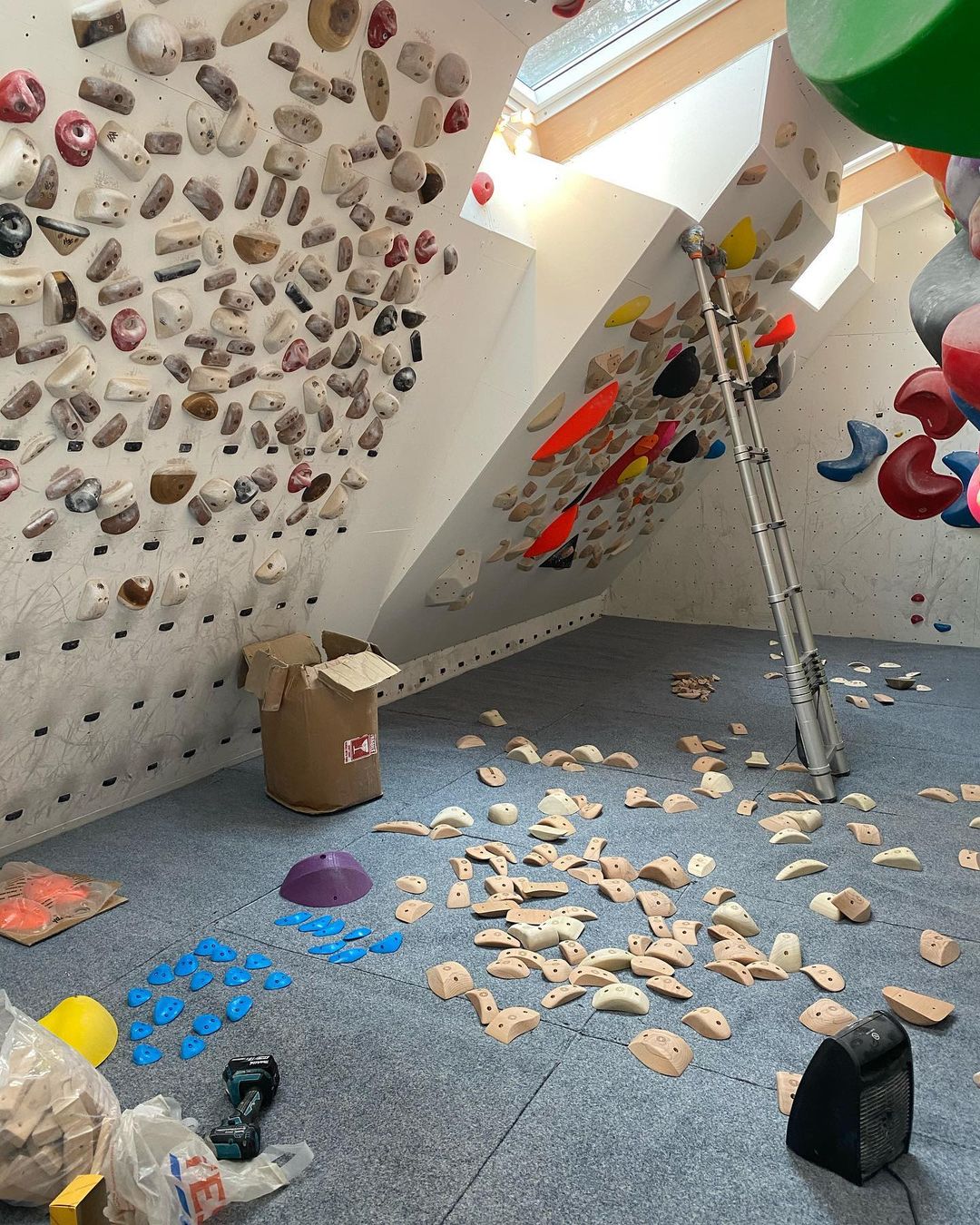
Creating a DIY climbing wall for kids is an exciting project that involves building a sturdy frame, mounting a climbing surface with plywood, and attaching varying climbing holds. This section outlines the essential steps for constructing a safe and enjoyable climbing wall.
Building the Frame
The foundation of a DIY climbing wall is a robust frame, which ensures the stability and safety of the wall. Begin by measuring and cutting the 2x4s to create the vertical supports and horizontal crosspieces for the frame. One should assemble these using carriage bolts and washers for secure connections.
- List of Materials:
- 2×4 lumber for frames
- Carriage bolts and washers
- Power drill
- Assembly Steps:
- Measure and cut the 2x4s to length using a tape measure and saw.
- Arrange the 2x4s to form the frame structure.
- Drill holes and connect using carriage bolts and washers.
Mounting the Climbing Surface
Once the frame is constructed, the next step is to mount the plywood which will serve as the climbing surface. It is imperative to use thick enough plywood to support the weight of climbers and secure it to the frame using screws. Furring strips can be added behind the plywood for additional support.
- Tools and Materials:
- Plywood sheets
- Screws
- Furring strips
- Power drill
- Jig saw
- Installation Guide:
- Cut the plywood to the desired size with a jig saw.
- Position furring strips on the back of plywood for reinforcement.
- Secure the plywood to the frame with screws.
Attaching Climbing Holds
Attaching the climbing holds is the final step in the construction process. Climbing holds come in various shapes and should be evenly distributed across the climbing surface to create routes of differing difficulty. A power drill is used to carefully place the holds and they are secured with appropriate bolts, ensuring they are tight enough to prevent spinning or moving.
- Required Supplies:
- Assorted climbing holds
- Bolts specific for climbing holds
- Power drill
- Attachment Process:
- Plan the layout of the climbing holds.
- Drill holes in the plywood for the holds.
- Fix the holds onto the plywood using the appropriate bolts.
By meticulously following these steps, one can construct a durable and safe climbing wall that provides hours of entertainment and physical activity for kids.
Aftercare and Maintenance

Sustaining the safety and longevity of a climbing wall for kids requires consistent aftercare and maintenance. It is critical to adhere to a schedule of regular inspections and to keep the climbing holds clean.
Regular Inspections
To maintain a safe climbing environment, regular inspections are necessary. They should look for any signs of wear and tear, especially on crucial components such as bolts and screws. Here is a checklist to follow:
- Inspect holds: Check for looseness or damage.
- Examine bolts and screws: Look for any that may be rusting or coming loose.
- Check wall surfaces: Ensure there are no cracks or splinters.
- Review mats and padding: Look for signs of compression or degradation.
Cleaning and Upkeep of Holds
Proper cleaning of the holds is important for both hygiene and grip quality. Here’s a simple guide to cleaning holds:
- Remove the holds using the appropriate tools, typically a wrench or screwdriver, depending on the type of hold and screw used.
- Wash holds with a mild detergent and warm water. For tough grime, use a soft brush to scrub.
- Rinse thoroughly with clean water.
- Dry completely before reattaching to the wall.
Remember to not overtighten screws when reattaching the holds, as this can cause unnecessary stress to the equipment. Regular cleaning also provides a good opportunity to inspect holds and screws more closely as they are removed from the wall.
Additional Climbing Wall Features
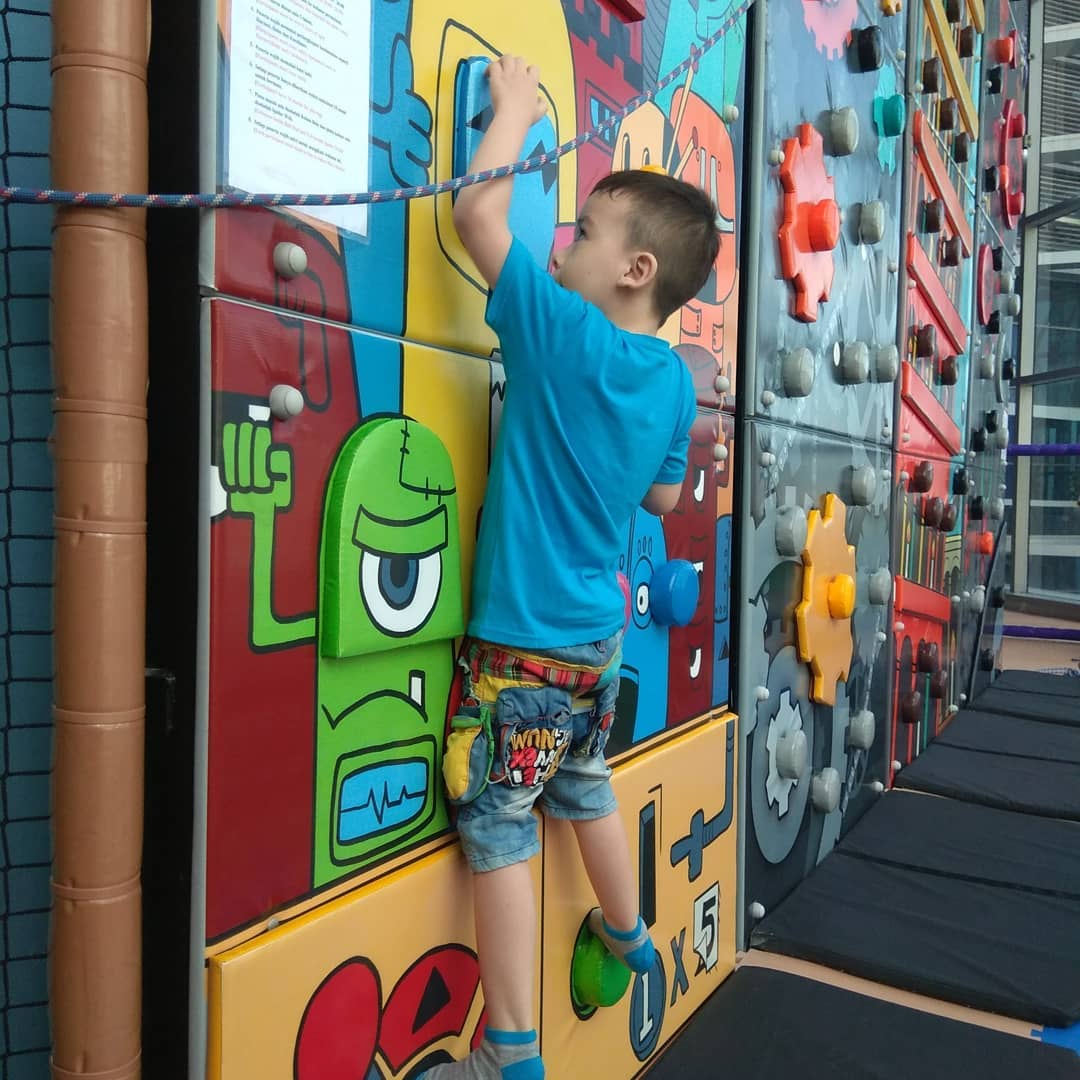
Enhancing a climbing wall with diverse features can significantly benefit a child’s climbing experience. These add-ons are designed to aid skill development and maintain engagement.
Dynamic Elements for Skill Progression
Climbing walls can be fitted with dynamic elements that challenge children as their climbing skills advance. Features such as movable holds allow for customization of the climbing route, presenting new difficulties as climbers become stronger and more adept. Including sliding panels or rotating sections can change the dynamics of the climb, introducing children to movements akin to those found in natural outdoor climbing environments.
Incorporating a Variety of Holds
A selection of climbing holds is critical for a stimulating experience:
- Standard Jugs: These are essential for beginners to safely learn climbing basics.
- Slopers: Their rounded shapes require more advanced grip strength and technique.
- Pinches: These holds help climbers develop a stronger grip by requiring them to pinch with their fingers.
- Crimps: Small and precise, crimps demand a higher level of finger strength and accuracy.
Adding holds of various shapes and sizes, integrated with rope and trim elements, can make the climbing wall more visually appealing and physically engaging. It’s important to ensure that all holds are securely mounted and that ropes are safely anchored to support the weight and movement of climbing children.
Incorporating Climbing Walls in Different Environments
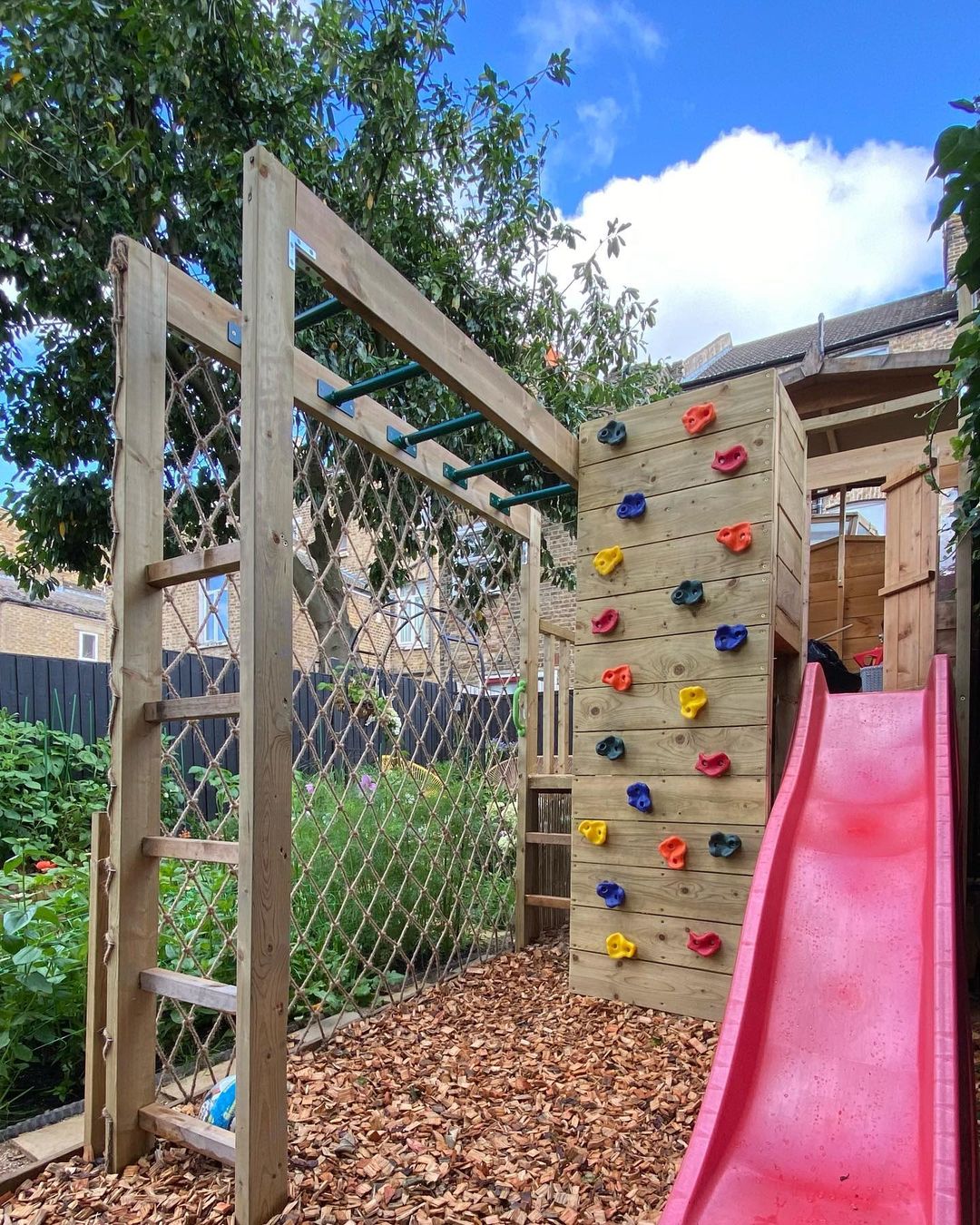
Climbing walls offer a dynamic way for children to build strength, enhance coordination, and develop problem-solving skills. By integrating climbing structures into varied venues, children from different backgrounds can enjoy the benefits of this versatile form of play and exercise.
Climbing Walls in Home Playgrounds
Home playgrounds provide a convenient and safe space for children to engage in physical activity. A climbing wall can be a standout feature, especially when designed to match the safety and developmental needs of kids. To incorporate a climbing wall in a home playground, one needs to consider available space, wall height, and hold types that are age-appropriate and encourage active play. For instance:
- Space Requirement: Ensure a clear fall zone of at least 6 feet around the wall.
- Wall Height: Keep the wall to a maximum of 8 feet for younger children.
- Type of Holds: Use various shapes and sizes to maintain interest and challenge.
By adding a climbing wall to a home playground—whether in a backyard or a basement—parents create an inviting space that challenges children physically and mentally while keeping them close to home.
Adapting Climbing Walls for Educational Settings
In educational environments such as schools or children’s museums, climbing walls should serve not only as play equipment but also as tools for learning. For successful integration into such settings, climbing walls can:
- Enhance Physical Education:
- Encourages full-body workouts.
- Builds dexterity needed for other sports.
- Support Cognitive Development:
- Incorporates color-coding or numbering for learning activities.
- Challenges problem-solving skills with varied routes.
Educators may include climbing walls as a central feature of a climbing gym within the institution or as a playground enhancement, emphasizing the importance of movement in the cognitive growth of children. Safety mats and supervision are crucial, ensuring a secure environment for all users.
Overcoming Challenges
Integrating a climbing wall for kids presents unique challenges, particularly when contending with limited space and navigating evolving COVID-19 restrictions.
Dealing with Limited Space
In constructing a climbing wall for kids, space constraints require innovative solutions. The design must maximize every inch with climbing paths that utilize vertical and horizontal elements. Modular panels or foldable designs come in handy, allowing for a setup that caters to the space available. For instance, a typical layout could consist of:
- Vertical Space: A wall height ranging from 6 to 8 feet, fitted with holds and grips.
- Horizontal Space: Expansion across the wall in zigzag or circular patterns to extend climbing routes without increasing the wall’s footprint.
Navigating COVID-19 Restrictions
Implementing a climbing wall under COVID-19 restrictions demands adherence to safety protocols. Facilities should establish a scheduled use policy to limit the number of climbers and allow for adequate cleaning between sessions. Personal protective equipment and sanitizer stations must be readily available. A summary of measures includes:
| Action | Description |
|---|---|
| Timed Entry | Climbers reserve slots to prevent overcrowding. |
| Equipment Sanitization | Regular cleaning of holds and safety gear. |
| Social Distancing Marks | Floor indicators to maintain safe distances. |
| Mask Usage | Mandatory in common areas and when not climbing. |
These specific guidelines ensure that climbers can enjoy the wall while minimizing the risk of COVID-19 transmission.
Why Climbing Gyms Matter for Young Climbers

Climbing gyms provide a structured environment where young climbers can safely develop their skills. These facilities are equipped with essential gear and offer a variety of climbing experiences, from bouldering to more advanced routes.
Learning from Experienced Climbers
Climbing gyms are staffed with experienced individuals who know the ins and outs of climbing techniques and safety procedures. They provide hands-on instruction and guidance which is vital for any young climber looking to improve. For example, a child may learn the correct way to execute a boulder problem or navigate gym mats and other equipment with the advice of a seasoned professional.
Engagement in a Climbing Community
In a climbing gym, young climbers are immersed in a community of peers and mentors. This community is a source of motivation and encouragement that pushes individuals to reach new heights. Additionally, regular interactions with this group allow for the exchange of knowledge and the formation of friendships based on a shared passion for climbing.
Conclusion
Climbing walls for children are a significant investment in promoting their physical health, mental well-being, and the development of valuable life skills. It is evident that these structures provide more than just entertainment; they contribute to children’s growth in various dimensions.
Physical Benefits:
- Enhances strength and flexibility
- Improves motor skills
- Promotes cardiovascular fitness
Cognitive Advantages:
- Develops problem-solving abilities
- Encourages goal-setting and achievement
- Stimulates spatial and proprioceptive awareness
Psychological and Social Gains:
- Boosts confidence and self-esteem
- Fosters teamwork and communication
- Teaches risk assessment and management
When integrating climbing walls in children’s environments, safety should be paramount. Proper installation, supervision, and the use of safety equipment are essential. Caretakers and instructors should ensure they are equipped with the necessary knowledge to maintain a secure environment.
Parents, schools, and community centers contemplating the addition of a climbing wall should consider the diversity of options available. They range from simple, smaller walls suited for young children to more complex structures designed for older kids and teenagers.
In summary, incorporating climbing walls in children’s play areas is a multifaceted tool that supports their overall development while they engage in a fun and challenging activity.

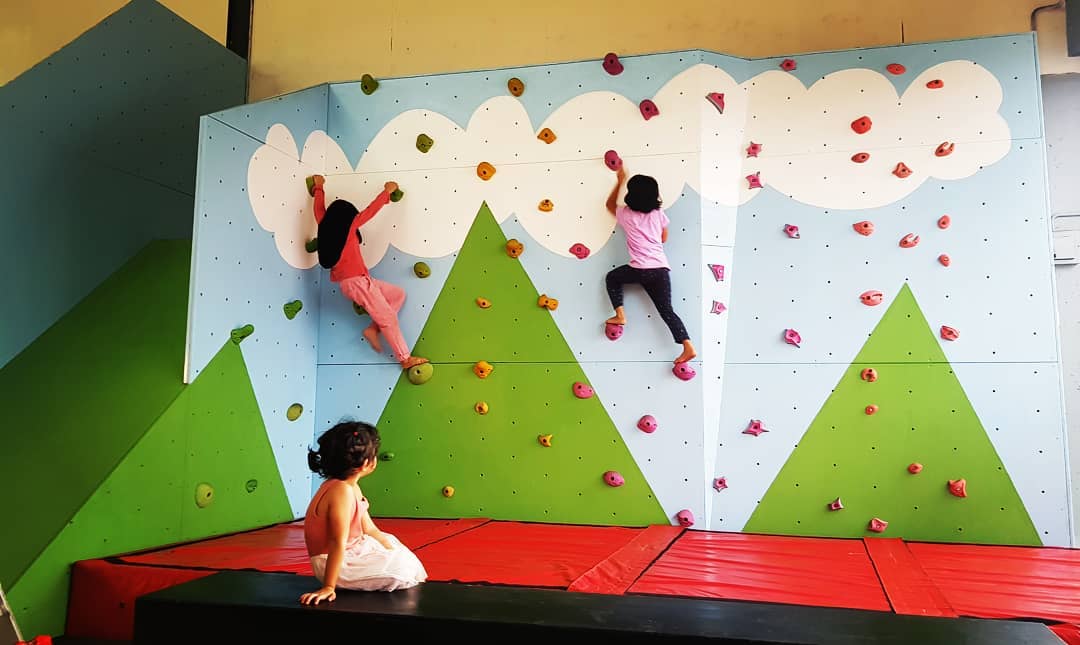

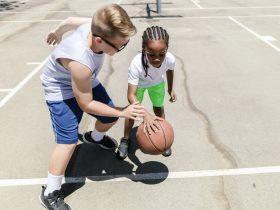

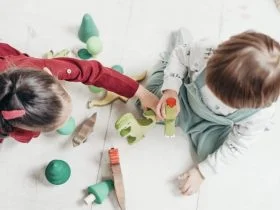
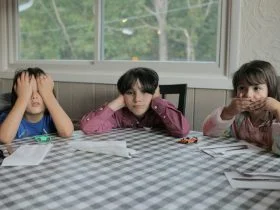
Leave a Reply
View Comments